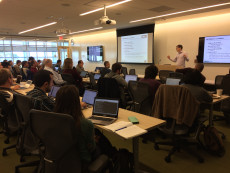NERSC’s First 'NESAP for Data' Teams Hit the Ground Running
January 18, 2017

The new NESAP for Data teams will participate in a coding "dungeon session" to be held at Intel in March.
Following a call for proposals issued last October, NERSC has selected six science application teams to participate in the NERSC Exascale Science Applications Program for Data (NESAP for Data) program.
Since the NESAP program was unveiled in 2014, NERSC has been partnering with code teams and library and tool developers to prepare and optimize their codes for the Cori manycore architecture. Like NESAP, the NESAP for Data program joins application teams with resources at NERSC, Cray and Intel; however, while the initial NESAP projects involve mostly simulation codes, NESAP for Data targets science applications that process and analyze massive datasets acquired from U.S. Department of Energy-supported experimental and observational sources, such as telescopes, microscopes, genome sequencers, light sources and particle physics detectors. The goal is to enable these applications to take full advantage of the Intel Xeon Phi Knights Landing (KNL) chipset on Cori.
The selected NESAP for Data projects are:
- Dark Energy Spectroscopic Instrument Codes; Stephen Bailey, Berkeley Lab (HEP)
- Union of Intersections Framework; Kris Bouchard, Berkeley Lab (BER)
- Cosmic Microwave Background Codes (TOAST); Julian Borrill, Berkeley Lab (HEP)
- ATLAS Simulation/Analysis Code; Steve Farrell, Berkeley Lab (HEP)
- Tomographic Reconstruction; Doga Gursoy, Argonne (BES)
- CMS Offline Reconstruction Code; Dirk Hufnagel, FermiLab (HEP)
"We're very excited to welcome these new data-intensive science application teams to NESAP,” said Rollin Thomas, a big data architect in NERSC’s Data Analytics and Services group who is coordinating NESAP for Data. “NESAP's tools and expertise should help accelerate the transition of these data science codes to KNL. But I'm also looking forward to uncovering and understanding the new performance and scalability challenges that are sure to arise along the way."
Through NESAP, the teams will have full access to Cori-KNL, plus NERSC Data Department expertise, testbeds and collaborations with vendors. Participants are already lining up to start submitting jobs to the KNL debug queues, according to Thomas. NESAP for Data participants will also be included in the various NESAP meetings and events, such as the upcoming dungeon session to be held in March at Intel’s Portland, Ore. facility.
Like the initial NESAP program, NESAP for Data also includes post-doctoral opportunities; the first NESAP post-doc to start working on the data projects is Zahra Ronaghi, who joined the NESAP program in January. NERSC is now in the process of reviewing more applications to fill two additional post-doc positions within NESAP for Data.
"We've learned a tremendous amount in the last couple years working with our existing NESAP teams to prepare their applications for Knights Landing,” said Jack Deslippe, acting group lead for NERSC’s Application Performance group. “We've developed an optimization strategy that the greater NERSC community can use to prepare for Cori. It's really exciting to get a chance to bring in some new data-centric applications—to apply some of what we've learned already but also to learn more from the unique challenges these apps face."
About NERSC and Berkeley Lab
The National Energy Research Scientific Computing Center (NERSC) is a U.S. Department of Energy Office of Science User Facility that serves as the primary high performance computing center for scientific research sponsored by the Office of Science. Located at Lawrence Berkeley National Laboratory, NERSC serves almost 10,000 scientists at national laboratories and universities researching a wide range of problems in climate, fusion energy, materials science, physics, chemistry, computational biology, and other disciplines. Berkeley Lab is a DOE national laboratory located in Berkeley, California. It conducts unclassified scientific research and is managed by the University of California for the U.S. Department of Energy. »Learn more about computing sciences at Berkeley Lab.







